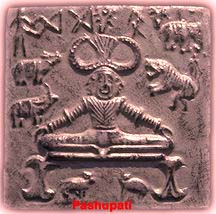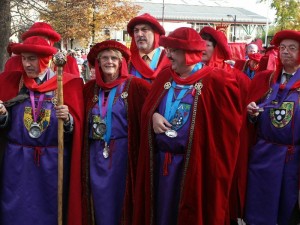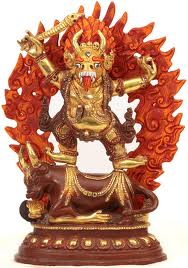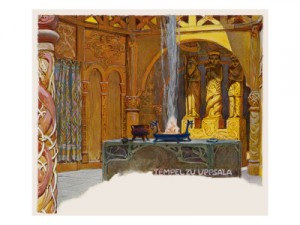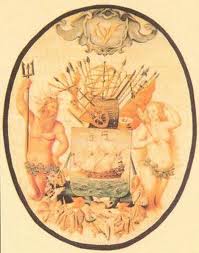Goddess Tara
If we read the ancient history of present day country “ Estonia” (Ly? - Ishtdevi?) . There was “Tharapita “ in the Estonia . तारा के हिल भी आयरलैंड में नहीं है. Both places are clue to history.Taarapita or Taara is a God in Estonian mythology. The holy place was also well known to Vironian tribes in northern Estonia. Taara फिनलैंड के Tavastian जनजाति से जाना जाता था. An old cult place now known as Laurin Lähde (Lauri फाउंटेन) Janakkala के काउंटी में. Tavastians worshipped Taara there as late as the 18th century and the church had to close the place. Estonia’s second-biggest city Tartu was poetically called Taaralinn (“city of Taara”).(Capital and largest city) .
In Indian form we says “Devi Tara”. It is very ancient vedic Godess. There was “Tarapith” in Vironian land Estonia , and there is hill of Tara in Ireland. Goddess Tara says us the story of High “Sanatan culture” prevailed in Europe.The story of Tara’s flight from Vironia to Saaremaa has been associated with a major meteor disaster that formed “Lake Kaali” in Saaremaa.
If look at Indian counterpart then there is Taratarini temple in present Orissa. Taratarini temple on bank of Rushikulya river. In Indian tradition Taratarini is called “Stan Khand”. It was Ishtdevi of Kaling rulers.Surprising Tarapith in Estonia (Ishtdevi?) and surruonding area is called Scandenevia (Stankhand?). पहले ही , Karelia rulers ruled there. So Hill of Tara in Ireland can not be clue to history of Great migration?
Triibe of Hindukush?
Yes Estonia is the country where Vironians dwells. In the Book
“The Kafirs of Hindukush”, we come across the tribe “Presun viron”. Robertson mentions that “Presun viron” tribe was very ancient tribe of Afghanistan. While Vronians of northern Estonia. were believer of “ Tara” . Is it merely coencidenc?
Now let us see what wickipedia says about Estonia And Tarapit. Estonia Officially the Republic of Estonia (एस्तोनियावासी: एस्टोनिया गणराज्य), is a state in the Baltic Region of Northern Europe. यह फिनलैंड की खाड़ी के उत्तर में bordered है, बाल्टिक सागर से पश्चिम तक, लातविया के दक्षिण में (343 कि.), and to the east by the Russian Federation (338.6 कि.).In present day there is Baltistan in Pak occupied Kashmir ,and there is Baltic zine in Europe. There is Kashmir in Bharatvarsha and there is Caspian see zone in Europe.These are not clues to History? Clue to great migration?
“Tharapita,Tharapita or Taarapita or Taara is a god in Estonian mythology.The Chronicle of Henry of Livonia mentions Tharapita as the superior god of Oeselians (Saaremaa द्वीप के निवासियों), भी अच्छी तरह से उत्तरी एस्टोनिया में Vironian जनजातियों के लिए जाना जाता है. Tharapita or Taarapita or Taara is a god in Estonian mythology.he chronicle, when the crusaders invaded Vironia in 1220, Vironia में एक सुंदर जंगली पहाड़ी थी, जहां स्थानीय लोगों का मानना Oeselian भगवान Tharapita पैदा हुआ था और जिसमें से वह Saaremaa के लिए उड़ान भरी.
The story of Taara’s flight from Vironia to Saaremaa has been associated with a major meteor disaster that formed Lake Kaali in Saaremaa. In fact Goddess “Tara” is a symbol and clue to ancient Aryan culture. Goddess Tara was also worshiped In Sindhu valley as well as in Hindukusha.
Some tribes of Britain and traditions also can provide clue to history. If we look at ancient tribes map of Britain then there are Gangani and Cocani tribes. Which are clear clue to Bharatvarsha. East and west Gangani dynasty ruled Orissa and south India. Now let us look at few more tribes and their traditions.
Link to My other article connects Tara hill( आयरलैंड) with Trihari garh (Tihari)
Parissi tribe – Cernunnos (Horned God) and Gandaberunda(Mysure)
The Parissi were a Celtic tribe who in pre-Roman times controlled almost all of the area which is now known as the East Riding of Yorkshire. Under Roman administration, the capital of their civitas was Petuaria, which today is known as Brough.
A tribe of the same name inhabited the part of Gaul presently occupied by central Paris; the notion that the tribes are connected—however conjectural—has proven powerful, the two peoples sharing Arras cultural characteristics in addition to a nominative identity. On the island of Great Britain, the Parissi were bordered by the Brigantes in the rest of the Yorkshire area and just across the Humber were the Corieltauvi. Paris city named after this Parissi tribe. They were worshiper of Cernwn (Cernunnos, Cernenus, Karnonos). Cernenusis a Gaulish and Cymric god known from two inscriptions from France and one from Germany as well as many images across the Celtic world. He is the classic stag-horned god of Celtic mythos who survives in Welsh folklore as Cernwn.
Pasis tribe of Lakhimpur Kheri
Lakhimpur Kheri is a District of Uttar pradesh in the Lucknow Division. It is located in India. along the border with Nepal. The headquarters of the Lakhimpur Kheri District are situated in the city of Lakhimpur.
Traditions point to the inclusion of this tract in the realm of the Lunar race of Hastinapur, and several places are associated with episodes in the Mahabharta. The early history is, however entirely unknown. The northern part was held by Rajputs in the tenth century, and tradition relates that they dispossessed by the Pasis (A Hindu Cast)and other aboriginal tribes.
it was restored to Oudh ( अवध) after the Anglo Nepalese War of 1814-16. On the annexation of Oudh in 1856 the west of the present area was formed in to a District called Muhamdi(Now Mohmmadi) and the cast into Mallanpur, which also included part of Sitapur.
Horned God Cernenus is a clue to ancient God of Bharatvarsha – Sangrila or Pashupatinath?
The cern- component of the name is derived from the Brythonic corn- where it means ‘horn’, as the root does in modern French. Thus Cernunnos literally means ‘The Hornéd One’. तथापि, it is uncertain how widespread the use of the exact name for this deity was; however iconography consistent with this deity have been found from Cisalpine Gaul (इटली) through Gaul to Denmark (the famous Gundestrup Cauldron) through to insular sources. The British representation of this deity may be a continental import as they occur in areas of Belgic influence such as the Cirencester (Corinium Dubunnorum) relief and the Meigle stone, Perthshire.
The image seems close to the description of Cernunnos on the Gundestrup cauldron implying the continuation of this deity’s mythos where we see the deity in his form as ‘lord of the wild beasts’.
Are the famous Gundestrup Cauldron and horned God Cernunnos is clue to Sindhu valley culture? Pashupatinath worshiped in Sindhu valley in that form. Further I want to remind you that our present search and research journey started with Afghanistan. If you read the book –“Kafirs of Hindukush” by Robertson then you will find description of religious Dance wearing Horned Mask. The Horned God tradition is clue to Sindhu culture. Is it not clue to great migration ?
Parissi
If we believe this clue than Porus who faught against Alexander was King of Paurava 326 ई.पू.. Warhero Brennus, who lead army against Greece and Delphi(279 ई.पू.) also belonged to “Prausi” tribe.Indian litrature says that According to ancient history traced to Vedas, the Ravi River was known as Iravati (also spelt Airavati). Another Vedic name was Purushni. Part of the battle of the ten kings was fought on the Parushni River, which according to Yaska (Nirukta 9.26) refers to the Iravati River (Ravi River) in the punjab
One scholar, Buddha Prakash, Professor of History and of Ancient Indian History, Culture and Archaeology, Director of the Institute of Indic Studies (1964); in his book Political and Social Movement in Ancient Punjab states:
The Purus settled between the Asikni and the Parusni, whence they launched their onslaught on the Bharats, और प्रारंभिक Dasrajan युद्ध में प्रतिघात के बाद, , regrouped और जल्द ही फिर से शुरू यमुना और सरस्वती पर उनके जुलूस और बाद Bharatas साथ विलय, उनके बंद शूटिंग के कुछ पंजाब में lingered और उनके एक scions सिकंदर के निमंत्रण पर एक समय की घटनाओं में उल्लेखनीय भूमिका निभाई थी. वे शायद पुरी के नाम के तहत पंजाब में बच, which is a sub-caste of the Khatris.It is Said that Puru dynasty is generally understood to be that of the Pandavas. The Harikulas( Krishna and Balram) have been identified by some scholars as none other than the descendants of Yadu. Surprisingly Brennus belonged to “Prausi” tribe and he took leadership of ( 280 ई.पू. )a great army, के बारे में शामिल 85,000 योद्धाओं, coming from Pannonia.
Gundestrup Cauldron is clue to Gandaberunda symbol of Mysure state? South Indian states were also carrying tradition of Sindhu culture. ( For further facts for Gandaberunda pl. look in the Mythological news section.
Now we know that Periyar rulers were in root of Ernakulam History. Those Priyar rulers are clue to Frissian or Phryginas who were named Frank latter on.
In Nennius the name Mannus (see Mannaz) and his three sons appear in corrupted form, the ancestor of the Irminones appearing as Armenon. His sons here are Gothus, Valagothus/Balagothus, Cibidus, Burgundus, and Longobardus, whence come the Goths (and Ostrogoths, Visigoths, Crimean Goths), Valagoths/Balagoths, Cibidi, Burgundians and Lombards/Langobards
Jormun, the Viking Age Norse form of the name Irmin, can be found in a number of places in the Poetic Edda as a by name for Odin. "
Mythology says that Odin and his brothers used Ymir’s lifeless body to create the universe. They carried it to the center of Ginnungagap and there they ground his flesh into dirt. The maggots that appeared in his flesh became the dwarves that live under the earth. His bones became the mountains, his teeth rocks and pebbles. Odin strewed Ymir’s brains into the sky to create the clouds, and took sparks and embers from Muspelheim for the sun, moon and stars. The gods placed four dwarves—Norðri (उत्तर), Suðri (दक्षिण), Austri (पूर्व), and Vestri (पश्चिम)—to hold up Ymir’s skull and create the heavens.
“Ymir was the first to be conceived as drops of eitr joined together and formed a giant of rime frost (a hrimthurs) and sparks from Muspelheim brought him to life. While Ymir slept, the sweat under his arms became two more giants, one male and one female, and one of his legs mated with the other to create a third, a son Þrúðgelmir.”
These were the forebearers of the family of frost giants or jutuns. They were nursed by the cow giant Auðumbla who, Ymir की तरह, was created from the melting ice in Ginnungagap. Auðumbla herself fed on a block of salty ice, and her licking sculpted it into the shape of a man who became Búri, the ancestor of the gods (Aesir) and the grandfather of Odin.
व्युत्पत्ति
अलग भारोपीय कहानियों का विश्लेषण प्रोटो-इंडो-यूरोपीय मानव जाति के दो पूर्वज नहीं थे माना जाता संकेत मिलता है: मनु- ('द मैन'; भारतीय मनु; युरोपीय Mannus) और Yemo- ("जुड़वां"), his twin brother.( Does it not match the history of founding of Ayodhya by Manu?) बाद वाला, Ymir की तरह, was sacrificed and carved up by his brother to produce mankind.”
Traces of this dualistic structure of (भी) the Proto-Indo-European creation myth can be found in parallel mythological entities with the same etymology, like the Indic death deity Yama and Avestan Yima, progenitors of mankind; of Remus (according to Jaan Puhvel), the brother of Romulus in the story of the founding of Rome, and Ymir. The underlying Proto-Indo-European form is *yemo (“twin”). The corresponding Proto-Germanic form was either *umijaz or, in better accordance with this theory, *jumijaz.
Yama shares with Ymir the characteristics of being primordial and mortal, but otherwise developed towards a very different character, the first of mortal men and kings who after death becomes ruler of the realm of the dead.
Now let us check what our ancient history of India says.
What our history says ?
"अग्नि" मनु के बचपन के दोस्त,अयोध्या के लिए आया था,form the distant west. He told Manu that that VAIVASWATA YAMA his (मनु) younger brother was alive after great flood. Agni told that Yama went towards the mountains towards west.On the seashore he found lot of dead bodies.The flood and then the epidemic ,which followed had taken the lives of all the residents of that place.He called it Mrutyulok.At the seashore Yama founded two colonies named Swarga and Narka.Yama ruled from there according to religious traditional note. Manu was happy to learn the well being of his younger brother Yama. (पी -93)
हां, ancient history of Bharatvarsha (भारत) says that Yama, the younger brother of Manu ( Founder of Ayodhya) was rescued in flood and Yama went towards the west. समुंदर का किनारा पर वह मृत शरीर का एक बहुत कुछ पाया . उन्होंने कहा कि Mrutyu लोक यह कहा जाता है . On the seashore Yama founded two colonies named Swarga and Narka .He ruled from there.
Means they are keep history of origin of creation.
————————————————————-
Har and Hari
करने के लिए लिंक Hermiones mentions that….it included Suebi ,Hermunduri,Chatti and Cherusci tribes.
You read the link carefully……They never hide their origin and we never believe it. The term Indo – European undoubtedly stands for India and Europe. Then what they hide? nothing ? why we don’t believe it?
इससे लिंक करें Suebi....I read Shiva only.
Suebi has roots in Suiones only. then why we doubt? The term Bastarane and Chatti also says about Indo – european roots. Is not ? Do Cherusci is not reminder to Choryashi (84)?
Do these tribes do not connects Baltistan and Baltic sea ? Ya it is.
इससे लिंक करें Baltistan...little Tibet.
करने के लिए लिंक Baltic sea ..Baltic sea..Our scripture mentions that Shiva was Trilokpati…Then why not believe this facts?
इससे लिंक करें Hermundari…says that there was allinace between Hermundari and Sarmatians.Sarmatians who has origin in Saurashtra.
इससे लिंक करें चट्टी…..to understand one has to go deeper in to Chatari tribes of India . Who stands below Chhatra….Chatarapati.
करने के लिए लिंक Cherusic जनजातियों.
इससे लिंक करें Halstatt संस्कृति.
Go deeper in to Aedui (अवधी) and Helvetii.…who ever remained ally of Roman empire. and Know Lav vanshi and Valli Vanshi.
Link to my article will lead you to the realm of Halhal...पवित्र
Sweden stands for Sverige
Now if we look at geografical facts about Sweden , then we come accross Swarga and Narka colony there. “ Sverige ” is swedish pronuciation of sweden and there is Narke province in present sweden too.
निष्कर्ष : Accont of ancient Indian history about Yama (मनु के छोटे भाई) matches with present geography and culture of sweden. Irminones are Yum worshipers. Yama culture developed there.If we read “ The kafirs of Hindukush”, then there is the reference that kafirs were worshiper of “Imara” (Ymir). Kafirs were worshiper of God of war “ Gish “ too.
Now let us see what wickipedia says about sweden…
SWEDEN pronounced, स्वीडिश: Sverige pronounced sværj ( listen)), officially the Kingdom of Sweden (स्वीडिश: Konungariket Sverige (help•info)), is a Nordic country on the Scandinavian Peninsula in Northern Europe.
swedish name Sverige (a conjunction of the words Svea and Rike – the latter is still spelt with the letter g, “rige”, in modern Danish) literally means “Kingdom of the Swedes”, excluding the Geats in Götaland.Variations of the name Sweden are used in most languages, with the exception of Danish and Norwegian using Sverige, Icelandic Svíþjóð, and the more notable exception of some Finno-Ugric languages where Ruotsi (फिनिश) and Rootsi (एस्तोनियावासी) are used, names commonly considered etymologically related to the English name for Russia, referring to the people, रूसी ', originally from the coastal areas of Roslagen, Uppland.
Närke province
Närke (help•info) is a traditional Swedish province or landskap in middle Sweden. It borders Västergötland, Värmland, Västmanland, Södermanland and Östergötland. On Närke’s 4,100 km² surface area, 193,857 people live.
And tide of the time proceed further……………….
डच- जर्मन- Dewashch
If we go deeper in to the meaning of word sweden and Dutch,
we can come to the conclusion that the word have got its roots in Sanskrit word “ Dewashcha”. The logo of “ Dutch East india company “ also cepicted and conveys the same massage. There are a picture of “Sahiv and Parvati “ in the logo of the company. Shiva has Trishul in his hand. We can conclude through this facts that the Teutonic ( Tibetian ?) नायकों
Ingaevones, Iscaevones and Herminones is based on the names of three heroes of ancient Indian history 1. अग्नि. 2. IKSVAKU and 3.Yama.Yes I feel that “Teutonic has relation with ancient Tel river civilazitaion of Orissa.
Now let us see what wickipedia says about word Dutch….
If we refer etemology of some words -the ethnonym of the Swedes from a cognate of Old English Sweo-ðeod and Old Norse: Sui-þióð
के अतिरिक्त, þiuda- appears in Angel-ðeod (“Anglo-Saxon people”) and Gut-þiuda (“Gothic people”). The adjective derived from this noun, *þiudiskaz, “popular”, was later used with reference to the language of the people in contrast to the Latin language (earliest recorded example 786). The word is continued in German Deutsch (meaning German), English “Dutch”, Dutch Duits and Diets (the latter referring to Dutch, the former meaning German), Italian tedesco (meaning German), and Swedish/Danish/Norwegian tysk (meaning German).
Ya they are Devashch people. Who holds tradition of “Hala hal”..पवित्र.
इससे लिंक करें Holand will tell you further history.
हेग is reminder to Hugally and Gangasagar only. Only keepers of Halahal tradition can come to “Nabh dwip” के रूप में “Deota”…Dutch.It is Para Huggallly……just link Param Kamboj.
And Then Ikshvakuvanshi – Iscaevones
Jacob Grimm in his book “Teutonic mythology” Volume 1 ,mentions that
1. Inguio. Iscio. Irmino. The threefold division ^of all the German! into Ingaevones, Iscaevones and Herminones^ is based on the names of three heroes, इंगो, Isco, Hermino, each of whom admits oi being fixed on yet surer authority. (p-345) We shall discus “Iscaevones” in the coming chapter.
Don’t think that migration by Germanic tribes in 500 ई.पू.. was first occasion of Migration. After all Manu and Yama were brothers and after great flood they both brothers were in two different continents. Migration from both the ends occured freguently.
अध्याय -2 ends here. अध्याय -3 will be posted shortly.




